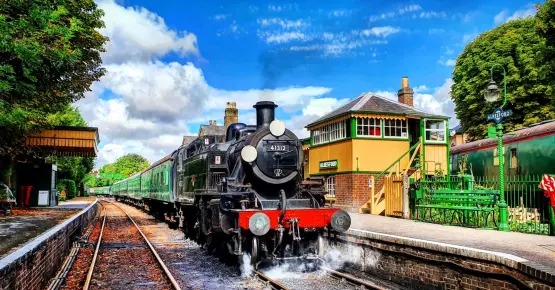
As the Flying Scotsman turns a hundred, it presents a chance to revisit the icons of the past that opposed cars.
In 2023, the Flying Scotsman locomotive, Britain’s most famous mechanical celebrity, will be celebrating its centenary since its emergence from the London & North Eastern Railway (LNER) Doncaster works in 1923. The National Railway Museum in York is holding an exhibition to commemorate this anniversary, along with special excursions and visits to heritage railways throughout the country.
Although commonly referred to as an icon, what exactly does the Flying Scotsman symbolize? To me, it represents the early stages of British PR. There were Flying Scotsman jigsaw puzzles, ashtrays, and paperweights. Additionally, the LNER often marketed the Flying Scotsman train, which boasted amenities such as an onboard barber, cinema carriage, and Louis XIV-style restaurant car. However, what was the reason behind all of the glamour?
The North Yorkshire Moors Railway.
The NYMR, like other heritage railways, was restored by volunteers after being shut down by Dr Richard Beeching in the 1960s. Beeching, a physicist, was appointed as the British Railways chairman by the Conservative transport minister, Ernest “Ernie” Marples – a figure that rail enthusiasts may consider similar to the villain Dick Dastardly. Marples, who owned a Jaguar and established a company that constructed roads, encouraged Beeching to apply a “scientific” method to Britain’s railways. Unfortunately, this approach resulted in a third of the network being cut without considering the usefulness or aesthetic value of the line, such as the beautiful route that once ran through the wild North York Moors from Whitby to Pickering.
The railway that runs through Kent and East Sussex.
Inaugurated in 1900 to cater to the farming community, this railway ceased operations in 1961 and was later restored in 1974. It belonged to the network of “Colonel Stephens railways,” which were constructed inexpensively by the eccentric Colonel Holman Fred Stephens as part of the country lines empire. Such railways were often unfenced and meandered through fields, while stations consisted of nothing more than a converted carriage and signals were often omitted.
The railway that runs through Romney, Hythe, and Dymchurch.
Although many of the events commemorating the centenary of the Scotsman have already sold out, you can still catch a glimpse of locomotives from the 1920s that were designed to resemble the Scotsman, but at a third of its size, if you visit the RH&D in Kent. The railway can be accessed by bus from Folkestone, Ashford or Canterbury. Among the locomotives, you’ll find the Green Goddess and Southern Maid, whose drivers can be seen polishing their boilers before embarking on their journey from Hythe. The railway runs behind bungalows facing the sea, leading towards the vast grey beach and the nuclear power stations at Dungeness. This setting further enhances the dreamlike quality of this 15-inch gauge railway line.



